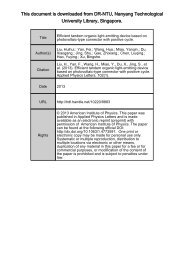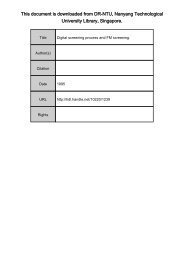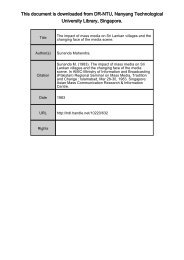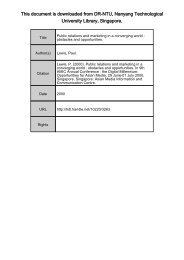annel Length and External Series Resistance Models of Scaled LDD ...
annel Length and External Series Resistance Models of Scaled LDD ...
annel Length and External Series Resistance Models of Scaled LDD ...
You also want an ePaper? Increase the reach of your titles
YUMPU automatically turns print PDFs into web optimized ePapers that Google loves.
IEEE TRANSACTIONS ON ELECTRON DEVICES, VOL. 48, NO. 5, MAY 2001 1003<br />
TABLE I<br />
EXTRACTED COEFFICIENTS FOR THE R<br />
OUR DEVICES<br />
AND 1L MODELS FOR<br />
Combining the gate bias modulation, temperature <strong>and</strong> body bias effects,<br />
the R TOText () <strong>and</strong> L e (m) are modeled as<br />
R TOText (V SG ;V SB ;T)=aT + b 0 c(V SG 0 V te ) 0 dV SB (3)<br />
L e (V SG;V SB;T)=L(m) 0 1L(V SG;V SB;T) (4)<br />
1L(V SG ;V SB ;T)=eT + f 0 g(V SG 0 V te ) 0 hV SB (5)<br />
Fig. 3. Dependence <strong>of</strong> R <strong>and</strong> 1L on source-body voltage V <strong>and</strong><br />
temperature (inset).<br />
where a; b; c; d; e; f; g; <strong>and</strong> h are coefficients extracted experimentally,<br />
given in Table I. The validity <strong>of</strong> the proposed R TOText , L e <strong>and</strong> V te<br />
models are verified by applying the modeled values into conventional<br />
drain current model expression as in [16]. Fig. 4 demonstrates good<br />
agreements between the experimental <strong>and</strong> modeled drain current characteristics<br />
for a wide range <strong>of</strong> biases <strong>and</strong> temperatures.<br />
IV. CONCLUSIONS<br />
The R TOText <strong>and</strong> L e <strong>of</strong> scaled hybrid-mode devices have been<br />
investigated. Together with a novel V te expression, analytical L e<br />
<strong>and</strong> R TOText models useful for devices operating in a Bi-MOS hybrid-mode<br />
environment have been presented. By including the effect <strong>of</strong><br />
body bias <strong>and</strong> temperature in the R TOText , L e , <strong>and</strong> V te models, the<br />
drain current characteristics <strong>of</strong> scaled devices operating in a Bi-MOS<br />
hybrid-mode environment can be predicted accurately using conventional<br />
drain current expression.<br />
ACKNOWLEDGMENT<br />
Fig. 4. Prediction <strong>of</strong> the drive current (solid lines) for different temperatures,<br />
gate lengths <strong>and</strong> body/gate terminal biases. The markers , }, <strong>and</strong> 4 represent<br />
the measurement data for V = 0 V, 0.4 V, <strong>and</strong> 0.6 V, respectively.<br />
[4], a very slight increment in R TOText <strong>and</strong> 1L with temperature<br />
has been observed, as depicted in Fig. 3 (inset). Although applying<br />
V SB > 0 V reduces the charge sharing effect [5], [7], narrowing<br />
<strong>of</strong> the depletion width at the source-body <strong>and</strong> drain-body junctions<br />
lengthens the effective ch<strong>annel</strong> region, justified by the reduction in<br />
1L with increasing V SB as indicated in Fig. 3. It is interesting to note<br />
that this ch<strong>annel</strong> lengthening effect appears to increase the numerator<br />
<strong>of</strong> the second term in (1), <strong>and</strong> hence the ch<strong>annel</strong> resistance. However,<br />
applying V SB also causes the physical broadening <strong>of</strong> the ch<strong>annel</strong><br />
formation under the gate. In contrast, this phenomenon reduces the<br />
intrinsic ch<strong>annel</strong> resistance. As mentioned earlier, increasing V SB<br />
reduces V te . This effect reduces the ch<strong>annel</strong> resistance per unit<br />
length <strong>and</strong> is well represented by utilizing V te in the second term in<br />
(1). As compared to V SB =0V condition, I SD increases when the<br />
device is biased with V SB > 0 V. For a fixed V SD, R tot = V SD=I SD<br />
reduces as a result. From the experimental results, the drop in R tot<br />
resulted from the increase in ch<strong>annel</strong> carriers collected at the drain<br />
region is also reflected in the trend <strong>of</strong> R TOText, as shown in Fig. 3.<br />
Therefore, the results have proven that one important contributing<br />
factor to I SD increment for V SB > 0 V is the composite effect<br />
between the resultant R TOText , 1L, <strong>and</strong> V te .<br />
The authors would like to acknowledge Chartered Semiconductor<br />
Manufacturing Ltd for supplying the test wafers. They are also grateful<br />
to the reviewers for their valuable comments.<br />
REFERENCES<br />
[1] S. S. S. Chung <strong>and</strong> J. S. Lee, “A new approach to determine the<br />
drain-<strong>and</strong>-source resistance <strong>of</strong> <strong>LDD</strong> MOSFETs,” IEEE Trans. Electron<br />
Devices, vol. 40, pp. 1709–1711, Sept. 1993.<br />
[2] J. Y. C. Sun, M. R. Wordeman, <strong>and</strong> S. E. Laux, “On the accuracy <strong>of</strong><br />
ch<strong>annel</strong> length characterization <strong>of</strong> <strong>LDD</strong> MOSFETs,” IEEE Trans. Electron<br />
Devices, vol. ED-33, pp. 1556–1562, Oct. 1986.<br />
[3] G. J. Hu, C. Chang, <strong>and</strong> Y. T. Chia, “Gate-voltage-dependent effective<br />
ch<strong>annel</strong> length <strong>and</strong> series resistance <strong>of</strong> <strong>LDD</strong> MOSFETs,” IEEE Trans.<br />
Electron Devices, vol. ED-34, pp. 2469–2475, Dec. 1987.<br />
[4] Y. Taur, D. S. Zicherman, D. R. Lombardi, P. J. Restle, C. H. Hsu, H. I.<br />
Hanafi, M. R. Wordeman, B. Davari, <strong>and</strong> G. G. Shahidi, “A new shift <strong>and</strong><br />
ratio method for MOSFET ch<strong>annel</strong>-length extraction,” IEEE Electron<br />
Device Lett., vol. 13, pp. 267–269, May 1992.<br />
[5] S. Hong <strong>and</strong> K. Lee, “Extraction <strong>of</strong> metallurgical effective ch<strong>annel</strong><br />
length in <strong>LDD</strong> MOSFETs,” IEEE Trans. Electron Devices, vol. 42, pp.<br />
1461–1466, Aug. 1995.<br />
[6] Y. S. Jean <strong>and</strong> C. Y. Wu, “A new extraction algorithm for the metallurgical<br />
ch<strong>annel</strong> length <strong>of</strong> conventional <strong>and</strong> <strong>LDD</strong> MOSFETs,” IEEE Trans.<br />
Electron Devices, vol. 43, pp. 946–953, June 1996.<br />
[7] C. M. Wu <strong>and</strong> C. Y. Wu, “A new method for extracting the<br />
ch<strong>annel</strong>-length reduction <strong>and</strong> the gate-voltage-dependent series resistance<br />
<strong>of</strong> counter-implanted p-MOSFETs,” IEEE Trans. Electron<br />
Devices, vol. 44, pp. 2193–2199, Dec. 1997.<br />
[8] T. H. Chang, J. G. Lo, T. C. Kuo, C. C. H. Hsu, S. Y. Yu, K. F. Tseng, <strong>and</strong><br />
L. S. Lu, “Effective ch<strong>annel</strong> length <strong>and</strong> source-drain series-resistance determination<br />
after electrical gate length verification <strong>of</strong> metal-oxide-semiconductor<br />
field-effect-transistor,” Jpn. J. Appl. Phys., vol. 37, part 1, no.<br />
3A, pp. 796–800, Mar. 1998.






